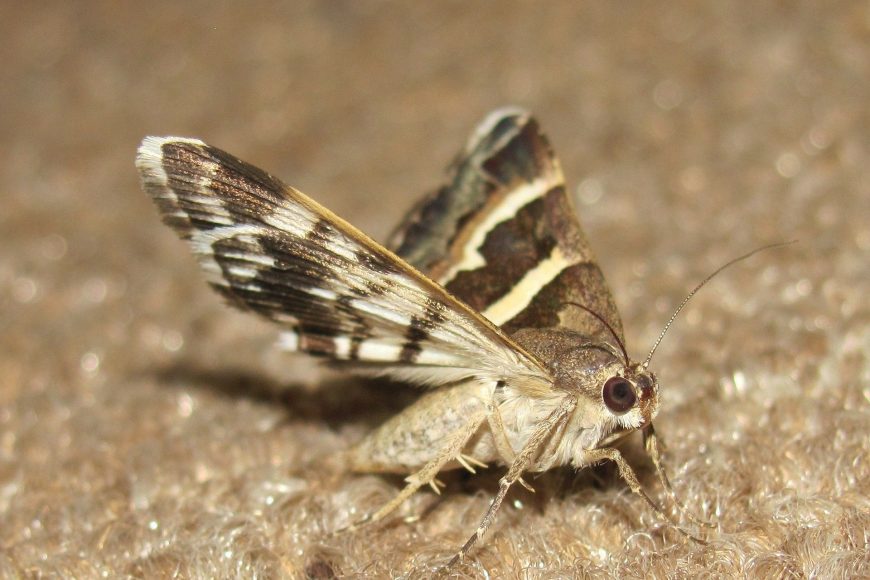- By CycreekPestAdmin
- In General
- Tags General
If you’ve ever discovered mysterious holes or other damage in your natural fabric items, or you’ve come across evidence of an infestation such as insect eggs or feces, then you know fabric pests can be annoying at best, and very costly at works. Some of the most common items attacked by fabric pests include rugs, clothing (particularly in storage), pillows, upholstered furniture, tapestries, and even leather book bindings.
These 5 fabric pests are important to be aware of as they can be invasive and destructive to your various pieces of clothing and fabric household objects:
1. Moths
Two types of moths should be watched out for when considered concern for your fabrics: Casemaking Clothes Moths and Webbing (or Common) Clothes Moths. These types of clothes moths and their larva do not pose a health risk to humans but can wreak havoc on your stored clothing and other fabric items—especially those made from natural fibers.
Typically growing between 7 and 12 millimeters long, moths are often brown or grayish in color and may or may not have spots on their wings. Adult moths are not eating your fabrics—it’s the larva that you should be wary of. As they grow into moths, larvae seek to protect themselves in a case of silk and other fibers. They’re not actually “eating” the fibers, but are using them to make a casing around themselves.
2. Beetles
These 2-5 millimeter pests may appear with yellow, black, and white colors in a swirled or mottled pattern, or they may range from red to dark brown to shiny black. Their shape is oval, similar to a ladybug. Carpet beetles come in various types but they all feed on fabrics as well as attacking stored food items. Although some people are certain that carpet beetles are biting them, these pests do not bite humans. However, the spiky hairs on the larva can irritate or even puncture sensitive skin and cause allergic reactions.
3. Crickets
Many people find these pests annoying because of their chirping habits, but crickets also like to munch on stained fabrics. Beverages, foods, laundry starch, perspiration, and other body fluids create an attractive scent for crickets, causing them to try to eat the remaining parts of the stain. This causes the fibers of your fabric to be compromised and holes will begin to appear, especially after laundering.
Crickets may be dark brown or black, but also can appear as a lighter brown color. Sometimes crickets are confused with grasshoppers as they have a similar shape and size, but grasshoppers are green. Crickets are medium in size with a body that is shaped with a sort of flat, cylindrical shape. They typically growing to be less than 2 inches long and enjoy hanging out in dark places.
4. Cockroaches
Cockroaches are disgusting creatures, carrying diseases and causing health problems such as asthma. However, many people don’t often realize that cockroaches can actually damage clothes and other fabric objects in the home. Because they are attracted to bodily fluid stains such as perspiration, as well as spills of food or drinks, cockroaches will try to chew at the stains—leaving the fabric riddled with cut fibers and holes. Excrement from cockroaches can also leave stains, some which will launder out but others which might not.
Cockroaches vary in size and color, but are usually some variation of dark brown or reddish-brown, growing up to between 1 and 2 inches long. In the state of Texas, approximately 30 different species of cockroaches exist and they are notorious for eating just about anything.
Read More: Understanding and Controlling Cockroaches
5. Silverfish
Similar to cockroaches and crickets, silverfish eat fabrics not for the material it is made of but for the substances found on the fabric. This might be laundry starch, various food and beverage stains, or body fluids. Silverfish thrive on a diet of starches and sugars, causing them to feast on sticky sweet stains on your clothing or even upholstered furniture. Because they prefer the darkness and humidity, your clothes are more at risk from a silverfish attack if they are stored in a warm, damp place.
Ranging from white to blue-silver to grey-brown, silverfish are shaped like a teardrop with long bristles growing on the narrow tail end. These nocturnal pests may grow up to 19 millimeters in length and they reproduce much more effectively in humid or damp areas.
Controlling fabric pests can be tricky situation and you may find that you need help from a pest control expert. Stay aware and watch for these troublesome pests to keep your clothing and household fabric items safe. Cypress Creek offers Houston pest control services, including inspections to determine what is “eating” your fabrics, and treatment options for fabric pest control. Schedule a consultation today!



